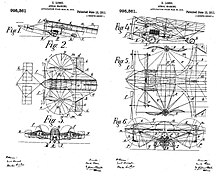Émile Lossé
Émile Lossé was a French inventor in the early 20th century.
Life
Lossé's life can only be reconstructed fragmentarily, as it is hardly mentioned in printed sources. This almost complete lack of information is unusual because Losse with one of his inventions in the years 1911 to 1913 obviously considerable interest in German air sports circles must have caused.
From the patent specifications that have been received, it can be understood that in 1910, when Lossé had his flying machine protected, he lived at 112 rue de Paris in Villeneuve-Saint-Georges in the southern outskirts of Paris and claimed to be an engineer by profession . With this first invention, as far as can still be seen today, he also received most of the attention; his flying machine was a gyroplane with two rotors attached to the side , but without wings . Lossés clearly attached great potential to its construction: He applied for patents in France, the United Kingdom , the USA , Belgium and Germany . However, only the French, British and American patents appear to have ultimately been granted. Even advocates of the still very young aviation with airplanes, at least in Germany, were probably convinced of the great value of the invention: An extensive campaign was organized to make the patents usable (see below).
Lossé's other inventions, it seems, did not attract any public attention. In 1913 he patented a two-stroke engine in France , in 1921 a car indicator in the shape of a hand and in 1922, when he was based at 3 rue Bardinet in Paris, another two-stroke engine. Lossé, now residing at 12 Rue de Cromeilles (today Rue des Martyrs de la Résistance) in Houilles , registered his last French patent in 1925: a silenced exhaust . After that his track is lost.
Lossé does not seem to have made any significant income from any of his inventions: his last documented house in Houilles still exists today and can be viewed on Google Street View . It is a very small, humble building.
Around Germany
An extensive campaign was launched in Germany to raise funds for the practical use of Lossé's gyroplane patent. The details of the action are difficult to determine; fixed, it is certain that in the interest of flying for the exploitation of the patent E. Losse a 3.5 quintals heavy ball with a circumference of 6 meters under the motto around Germany the ball rolls through places along the borders and coasts of the former German Reich rolled has been. The campaign started in Düsseldorf at Christmas 1911 and lasted a year and a half. Specially printed photo postcards were sold at the individual stations. Among other things, there are maps from Düsseldorf, Lübeck, Munich and Insterburg , where the ball was shown in December 1912. On whose initiative this action of the first circling of the German Reich went back - the postcards name one W. Hormann , who, however, could not be identified in connection with the early aviation - is unclear, as is the exact background of the company. The postcards suggest that 10,000 marks were hoped to be raised, presumably to finance the German patent and the construction of corresponding aircraft. Because the weight of the ball named on the postcards increased steadily (Düsseldorf: 3.5 quintals; Lübeck and Insterburg: 5 quintals; Munich: 25 quintals), it apparently contained the coins of the donations collected. Since gyroplanes according to Lossé's patent are not mentioned in works on the history of aviation and there is no evidence of a granted German Reich patent, the success fell short of expectations. It is not yet clear why this large-scale advertising and financing campaign, which indicated considerable interest in aviation circles at the time, was not mentioned in sources on aircraft history.
An unusual approach by the organizers was probably due to the nationalist atmosphere in the last few years before the First World War : Émile Lossé's nationality was hidden on the postcards by abbreviation of his first name with E. and the surname without an accent on the e . That this was a deliberate obfuscation is shown by a card that expressly names the inventor as E. Losse, Berlin . This indicates that the organizers of the ball run assumed that they could not expect any support for the promotion of a French inventor.
photos
The ball in Munich
The ball in Hotzenplotz
The ball in poses
The ball in Amsterdam
Lossé's patents
- GB000191006388A (United Kingdom) - Aerial Machines , March 14, 1910
- FR000000424683A (France) - Perfectionnements aux aéroplanes , March 19, 1910
- US000000995361A (USA) - Aerial Machine , March 22, 1910
- FR000000467763A (France) - Moteur à deux temps , April 5, 1913
- FR000000536162A - (France) - Appareil avertisseur destiné aux véhicules , February 28, 1921
- FR000000557107A (France) - Moteur à explosions à deux temps , February 1, 1922
- FR000000619383A (France) - Pot d'échappement silencieux pour moteurs à internal combustion , November 30, 1925
Web links
- Postcard of the ball from Düsseldorf at Spiegel Einestages
- International patent database of the German Patent and Trademark Office
Individual evidence
| personal data | |
|---|---|
| SURNAME | Lossé, Émile |
| BRIEF DESCRIPTION | French inventor |
| DATE OF BIRTH | 19th century |
| DATE OF DEATH | 20th century |





